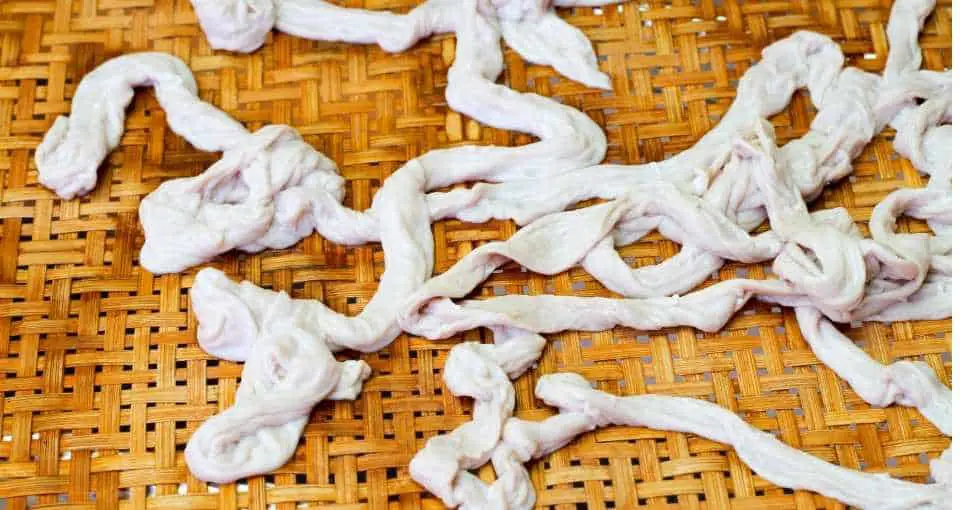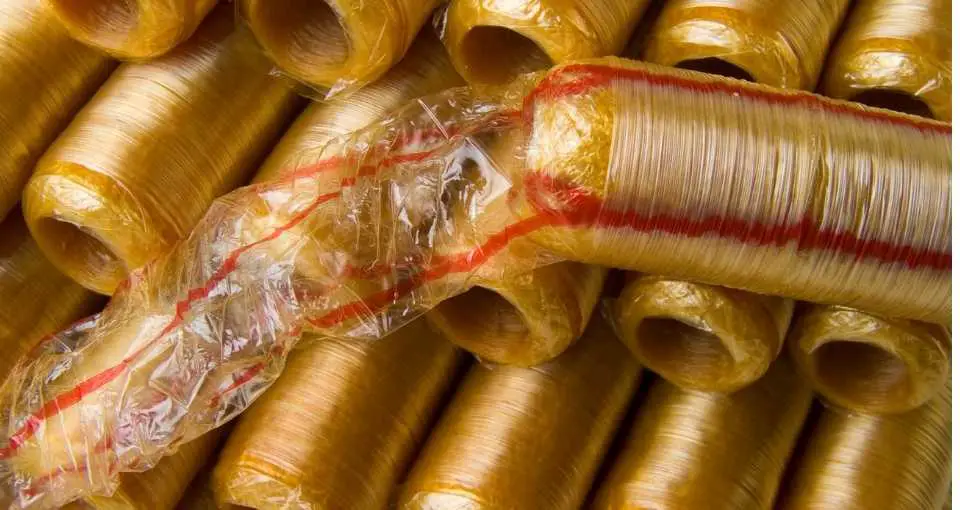Sausage casings can last a very long time when stored properly. Luckily storing them is pretty straightforward and simple. But there are definitely a few nuances between the types of sausages to understand first.
I wanted to put together an easy to follow guide that covered all there is to know about storing sausage casings.
So here is what I learned along the way to share with fellow sausage enthusiast.
Storing Sausage Casings…
Natural casings such as hog, sheep or cow are always best to use fresh as possible. Since even when freezing them, the quality will degrade over time.
Still freezing them is better than leaving them storing them on a counter or shelf. Which you should not do, any sunlight, humidity or temperature changes will ruin the casing.
Natural casings are made out of animal intestines. Unlike other casings, natural ones are the most perishable. Since there is not any synthetic material used to make them.
The only type of casings you don’t have to worry about going bad are artificial casings.
If you want to know which sausage casings are edible and which aren’t read: Sausage Casings 101: Which Ones Can You Eat?
How Do You Store Natural Sausage Casings Such as Hog?
You can store natural sausage casings in either a refrigerator or freezer. You should always keep natural casings sealed and in a wet brine or a dry salt to help preserve them.
Natural casings will have to be preserved properly since they are perishable, using a preservative is required for long term storage.
The best preservative to use is salt…
There are two types of salt preservation that can be used. Granulated or a salt solution called brine. Also refereed to by sausage makers as wet or dry brine.
Brine will be a wet salt, with extra liquid as opposed to granulated salt packing.
The main reason for a brine solution (wet brine) is to prevent freezer burn. Since the salt water will not freeze. Preventing the casing from freezing is good to keep it from tearing.
Wet brine is also better for storing a larger batch of casings. Dry brine is best for a smaller amount of casings. This is because you can use less salt with a brine but still have enough for a large batch.
Brine is good for freezing sausage, but dry salt works best for long term storage outside of a freezer.
Brine solution should be changed out regularly when storing the casings long term.
Try doing this quarterly, you can also check on the casing at this time to make sure they are holding up.
When using granulated avoid using any extra mineral sea salts. Sea salt with extra minerals can change the flavor and color of the natural casings.
Non-iodized, pure salt or kosher works best. Do not just use regular table salt.
The best way to preserve natural casings is to keep them in a airtight bag (vacuum sealed) or container. With the casing completely covered in salt. Do not let the temperature exceed 40 degrees Fahrenheit.
Refrigeration is the most recommended way to store sausage casings. Place them in the back of a refrigerator to keep temperature consistent.
When buying natural sausage casings, they aren’t shipped refrigerated. But they will come preserved in salt. You shouldn’t have to refrigerate them until you have opened package.
The period of time you are going to store them is important. Long term use dry salt, shorter term use a brine (or when freezing them).
Quick Recap
Salt is the best preservative for sausage casings and there are two ways to use salt. One is a wet salt called brine and the other is dry called granulated.
Refrigeration and freezing natural sausage casings is a must. Refrigerate with dry salt and freeze with a brine. Avoid heavy mineral and iodized salts.
How To Store Synthetic/Artificial Sausage Casings
Artificial casings are going to be made out of collagen (the appearance is clear and they are made from animal hide or bone, collagen is edible) and cellulose (non-edible fibrous casings made from wood pulp and fibers).
Storing artificial casings is about having a proper environment. Keep them out of direct sunlight, intense heat and moisture. Store them in a cool and dry place in a sealed package or container.
Fibrous casings are dehydrated already, so keep them dry until you are ready to use them. Since most dry sausages use a fibrous casing, the casing itself is shelf stable.
Collagen casings don’t have to be salted but should be kept in a refrigerator. This will prevent them from drying out any further. Which can cause the casing to crack. Also makes them less expansive and prone to splitting when stuffing them.
You can use the original packaging they came in if possible. When stored properly you can expect these casings to last up to two years.
Collagen casings are easier to store, and also to stuff with. Since they are less fragile and easier to prepare.

Can You Freeze Sausage Casings?
Each type of sausage casing can be stored in different ways. Certain ones will not hold up as well to being frozen. As mentioned earlier you can freeze sausage casings but you should do it properly.
When freezing natural sausage casing they should be first preserved in a wet brine solution. This will help to prevent freezer burn and crystallization on the sausage casing. Making sure they do not tear while freezing. You can freeze them this way for up to 2 years.
There is no point in freezing sausage casings if you are going to use them again in a week or two. Throwing them in a fridge is better for shorter periods of time.
How Can You Tell If A Natural Casing Is Bad?
Natural casings themselves, even when fresh. Have a strong distinct odor that isn’t pleasant. Sheep casings smell differently than hog and so on. This does not mean they are spoiled.
Sheep casings are also noted to have a stronger smell than the others.
One way to tell is the smell they will have. Since fresh ones stink anyways. You need to be able to notice if the smell has changed. Spoiled casings will have a rancid and sour smell to them.
If you are certain the casings are still good but the smell is really strong. Airing the casings out for a few minutes will help. You can then rinse them off and use new brine to soak them again for 30 mins.
You can soak them in a water and vinegar solution as well. Use one part vinegar to two parts water. Always soak in cold water. You can soak them for up to two days.
This can get rid of the smell enough to make working with them easier. Do this if they are stinking up your kitchen bad. You may need to open a window when using the casings at first.
The smell is strong after they have been sealed up for a period of time. It might seem like they have gone bad.
One way to check is to again rinse them off and see if the smell has diminished. Usually this works and the casings will not stink as strongly.
The smell if gone bad will be far worse than the natural smell. It will be obvious that something isn’t right.
It can be hard to notice at first if the smell is off, so if you are unsure move on to inspecting the appearance.
Any type of spotted discoloration is a sign they have gone bad. Mold will be easy to spot on the casings. Any type of alteration of the shape of the casing that doesn’t look natural.
Quick Recap
So if you are unsure about the casing because it smells. Try soaking and rinsing them off. If the smell does not go down considerably, then they have more than likely gone bad.
Also look for any serious alterations in appearance of casings. Natural sausage casings have a solid color. The texture is fairly uniform so you should notice any changes.
How To Prepare Sausage Casings
Preparing your sausages after storing them involves washing off excess salt. Also its important to re-hydrate them which is done by soaking them.
Sometimes soaking them takes care of both jobs. Washing off enough salt and properly hydrating them before use.
How good you wash them depends on how they were preserved. If you used dry salt then you might need to soak them for a period of time.
If you used a wet brine then you can simply rinse them off under the sink. Just make sure you are able to get rid of any excess salt that might affect the taste of the sausage.
Also the salt is going to take on some flavor from the raw casings so its best to get it all off completely.
There are only a few types of sausage casing that need soaking. Natural casings, fibrous casings and certain collagen casings. Cellulose casings will not need to be soaked.
Soaking them prior to stuffing is will make the casings more malleable. This helps to make a sausage that is evenly packed and much easier to work with.
How Long To Soak Sausage Casings?
The time required to soak the casings depends on the type. Natural casings take the longest, soak them for 60 minutes. Fibrous casings can be soaked for about 30 minutes.
These are the quickest soak times that can be done. Generally the fresher a casing the less soaking is required.
Other factors determine how long a casing should be soaked. The older the casing the longer it may need to be soaked. Also how strong the casing is and how dry.
In the case of older and more dry casings (either natural or synthetic), soaking them overnight can be done. Just make sure to start them with warm water. Then store them soaking in your fridge.
Then they should be introduced to warm water again prior to stuffing. This allows them to be easily stretched to prevent breaking.
Sausage Seasonings
You can ensure your sausages taste the best by using a sausage seasoning. Great for if you are just starting out or don’t have the time to mix your own.
Check out the best sausage seasonings on Amazon here.
Summary
In closing we have covered the two salt preservation types to pack or re-pack your natural casings into. The types are wet and dry salt and which one works better for different situations.
We also went into detail about the different types of sausage casings and the shelf life of each. Lastly we focused on how to prepare your sausages after refrigeration or freezing them before using them.

